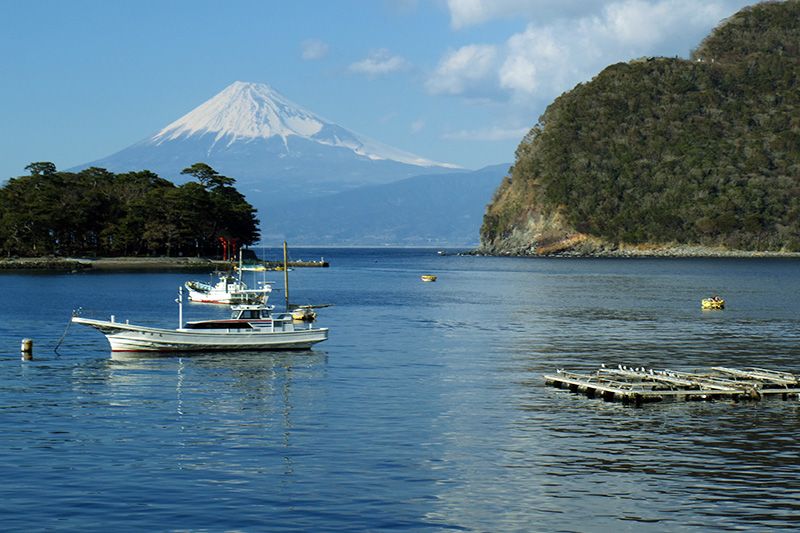
Relations with Russia: Remembering the Past
Politics Culture- English
- 日本語
- 简体字
- 繁體字
- Français
- Español
- العربية
- Русский
Relations between Japan and Russia have been strained of late. Despite close trading ties and geographic proximity, the two countries have never signed a formal peace treaty after World War II, largely because of a long-running territorial dispute over several islands in the Kuril chain north of Hokkaidō (known as the “Northern Territories” in Japan).
I recently had an occasion to reflect on the history of the relationship between the two countries when I joined representatives from the Russian Embassy on a “history trip” to Shimoda and Heda on the Izu Peninsula, a short journey from Tokyo. The trip was organized by the Japan-Russia Friendship Forum, which is chaired by the current prime minister, Abe Shinzō.
Putiatin Hurries to Catch Up with Perry
View Relations with Russia: Remembering the Past in a larger map
Shimoda and Heda have a special significance in the history of relations between Japan and Russia, thanks to their connection to Russian special envoy Euphimy Putiatin (1803–83), who signed the Treaty of Shimoda, the first treaty of commerce and navigation between the countries, in 1855.
Putiatin sailed to Japan on the orders of Czar Nicholas I, and arrived in Nagasaki in August 1853. But attempts to negotiate a trade agreement with the Tokugawa shogunate were initially unsuccessful and Putiatin temporarily returned to Russia. He was back again the following year, this time sailing into Hakodate in southern Hokkaidō in August 1854.
Putiatin learned that a delegation from the United States led by Commodore Matthew Perry had succeeded in opening Japan to trade five months earlier with the Treaty of Kanagawa. Putiatin promptly sailed to Osaka in his flagship, the Diana, arriving in September. He was now just 50 kilometers from the capital in Kyoto, a fact that caused considerable consternation at the imperial court and among the shogun’s advisors.
To avoid a further escalation of the situation, the shogunate instructed Putiatin to proceed to Shimoda. The Diana arrived in Shimoda harbor in October 1854 and Putiatin got ready for negotiations to begin.
Disaster Strikes
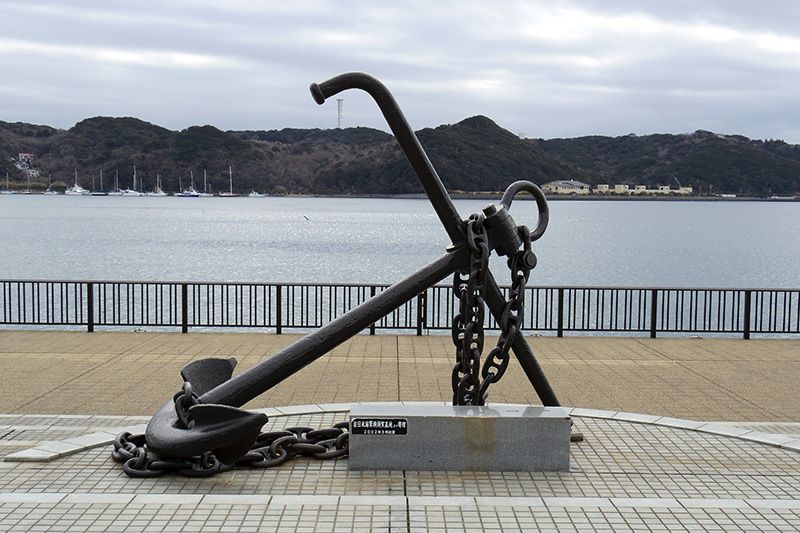 The anchor of the ship “Diana” on display at Heda.
The anchor of the ship “Diana” on display at Heda.
Just a month after Putiatin’s arrival in Shimoda, however, the Diana’s rudder and hull were seriously damaged when the harbor was struck by a major tsunami. During the chaos, members of the Russian navy managed to save the lives of several local residents as the town was swamped by a six-meter wave. Unlike the aggressive and threatening Perry, Putiatin and his men made a positive impression on the Japanese representatives.
Putiatin abandoned any hope of repairing his ship at Shimoda and decided to sail to Heda, on the opposite side of the Izu Peninsula, instead. The Diana was towed out of the harbor but soon started taking on water. The crew of nearly 500 were forced to disembark and make their way to Heda overland. The Diana sank soon afterward in Suruga Bay.
Undaunted by this disaster, Putiatin asked the Japanese authorities to build a new ship at Heda.
A New Ship is Built
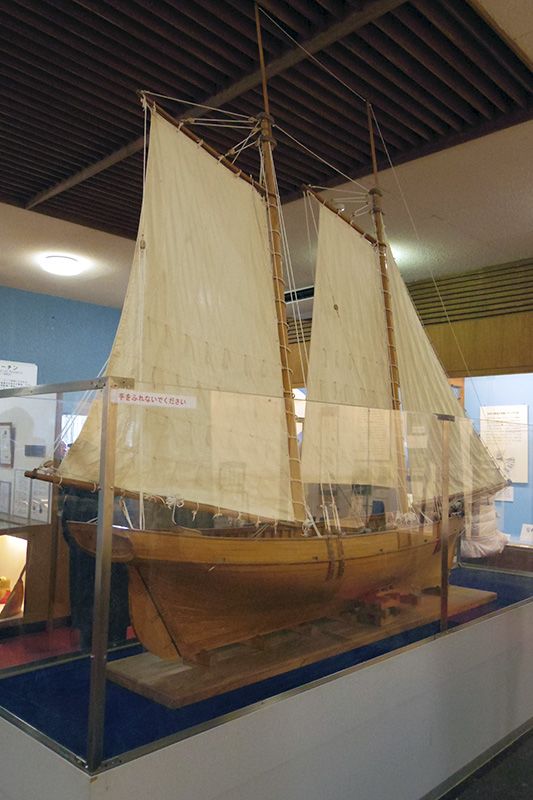 A model of the ship “Heda,” on display in a museum dedicated to the history of shipbuilding in Heda.
A model of the ship “Heda,” on display in a museum dedicated to the history of shipbuilding in Heda.
At the time, Japan had for several centuries followed a policy of seclusion known as sakoku (“closed country”), during which international relations were severely curtailed and Japanese people were forbidden from leaving the country. No one in Japan had the knowledge to build ocean-going ships. On top of this, the language barrier caused serious difficulties between the Russians and their Japanese hosts. Unable to explain what kind of ship they had in mind, the Russian engineers apparently made a full-size plan and had the local shipwrights cut the lumber to fit.
Two and a half months later, the first modern ocean-faring ship ever built in Japan was complete. The ship was nearly 25 meters long and weighed 100 tons.
To commemorate this remarkable early example of cooperation between Russia and Japan, Putiatin named the ship Heda.
The “Northern Territories” Dispute
While he waited for his ship to be built, Putiatin was working hard on securing a diplomatic agreement with Japan. His efforts bore fruit and the Treaty of Shimoda was signed in February 1855.
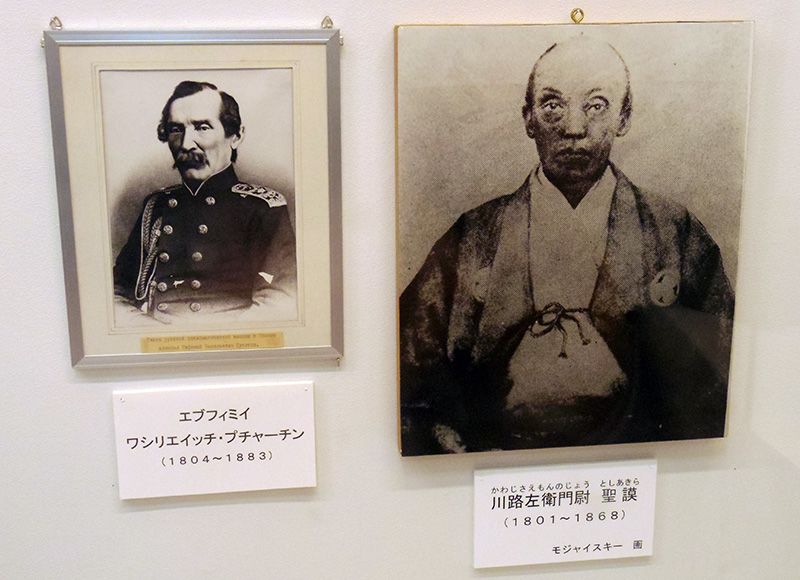 The men who signed the Treaty of Shimoda.
The men who signed the Treaty of Shimoda.
One of the important results of this treaty was a clear agreement on where the border between Japanese and Russian territory should lie. The “Northern Territories” issue that continues to cloud relations between Japan and Russia to this day can be said to have had its beginnings here.
The treaty declared that the border between Japan and Russia would be drawn between the two islands of Iturup and Urup, in the Kuril chain north of Hokkaidō. Iturup, Kunashir, the Habomai Islands, and Shikotan were defined as Japanese territory. The Japanese government continues to claim these islands, which were occupied by Soviet forces at the end of World War II and have been administered as part of Russia’s Sakhalin Oblast ever since. The Japanese claim dates back to the Treaty of Shimoda, which decreed that everything north of the island of Urup belonged to Russia and divided the major island of Sakhalin between the two countries.
Preserving the Past at Hōsenji
During his stay in Japan, Putiatin lodged at Hōsenji, a Buddhist temple in Numazu, Shizuoka Prefecture. The desk and chair he used, originally intended for Buddhist ceremonies, can still be seen in the temple today. The graves of two Russian sailors who died during their stay in Japan can also be found in the temple grounds. Russian tourists occasionally visit the graves to pay their respects.
One of the Russian representatives on the trip was Konstantin Vinogradov, who works in the Russian Embassy in Japan. Konstantin said he was impressed by how hard the people of Shimoda and Heda had worked to preserve their history, and stressed the importance of lasting cooperation between the two countries.
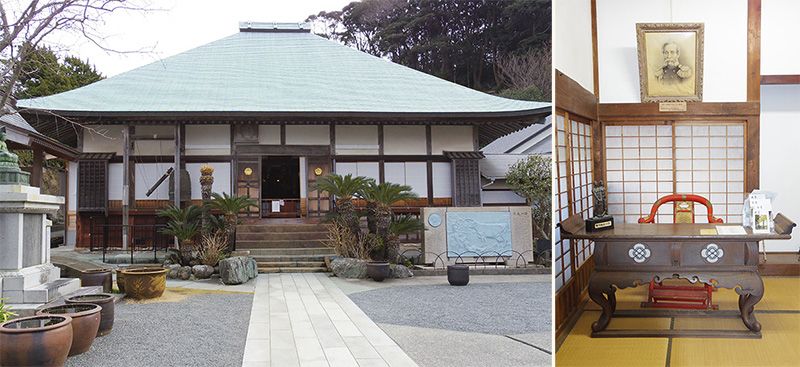 Hōsenji, where Putiatin stayed during his time in Japan (left). The desk and chair that Putiatin used (right).
Hōsenji, where Putiatin stayed during his time in Japan (left). The desk and chair that Putiatin used (right).
More Awareness of the Past Needed
Despite these promising beginnings, relations between Japan and its northern neighbor soured in the years that followed, eventually leading to the Russo-Japanese War of 1904–05. But the residents of Heda never forgot Putiatin and the respectful way he had conducted himself. They continued to honor his memory and cherish the possessions he had left behind.
In 1881 Putiatin was awarded the First Class Order of the Rising Son for services to Japan-Russia relations. He was the first non-Japanese person to receive the award.
In November 2005 the Japanese government presented President Putin with a model of the Heda to mark the 150th anniversary of Putiatin’s visit to Japan.
The problem of the disputed “Northern Territories” is one on which there is little room for compromise as far as the Japanese government is concerned. But the abiding impression that has stayed with me since my trip to Shimoda and Heda is that many people in Japan today are ignorant of the important events in our history.
If President Putin visits Japan again, I would urge him to make the short trip to the Izu Peninsula to see Shimoda and Heda in Izu, where the modern history of mutual respect and cooperation between our two countries began.
(Originally written in Japanese on February 24, 2013.)
